Imagine stepping outside your back door any month of the year and picking fresh greens, crisp root vegetables, or juicy berries. This dream becomes reality when you shift from seasonal planting to a strategic system that works with nature’s rhythms. For centuries, growers like French market farmers perfected methods to defy frost and snow, producing food even in January without modern gadgets.
Eliot Coleman, a Maine-based grower, proved winter gardening isn’t about fighting cold but managing it. His experiments show many crops thrive in cooler temperatures if protected properly. You’ll learn how simple tools like cold frames and smart crop rotation create a seamless flow between seasons.
The secret lies in viewing your space as both a growing area and natural pantry. Hardy kale or carrots planted in fall can stay fresh under mulch until spring. It’s not magic—it’s mimicking patterns found in resilient ecosystems.
Your location matters, but every climate offers opportunities. Coastal regions might focus on leafy greens year-round, while colder zones prioritize frost-tolerant varieties. Start small, observe what works, and let your plot evolve into a continuous food source.
Understanding Year-Round Gardening: An Overview
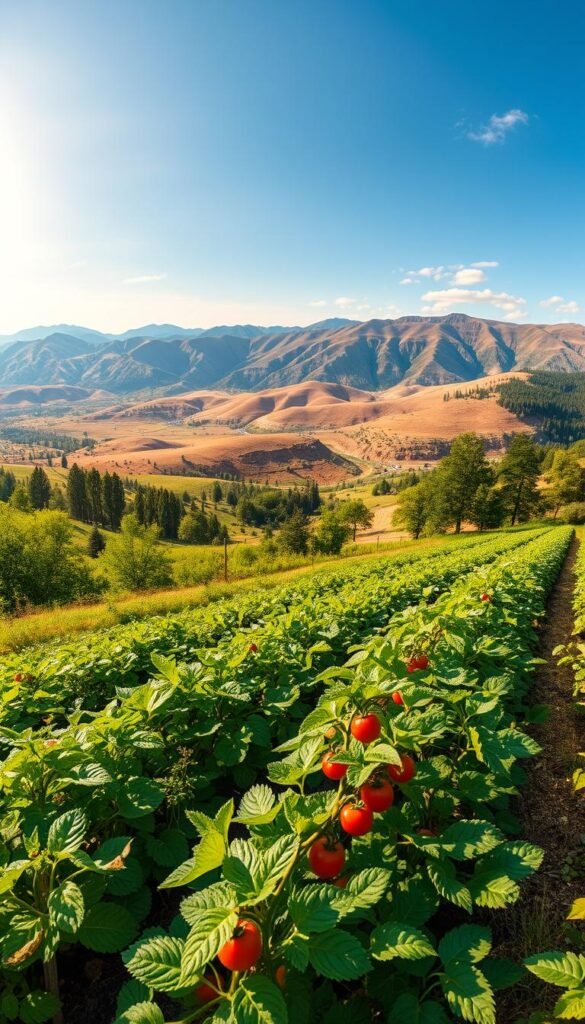
Fresh spinach in December or carrots in February might sound impossible, but climate-smart techniques make four-season growing achievable. The secret lies in matching plant varieties to your zone’s winter patterns rather than fighting nature. While Alaskan growers use heated greenhouses, Virginians might only need row covers for frost protection.
Temperature swings cause more issues than limited daylight for winter crops. Kale and Brussels sprouts actually sweeten after light frosts. Check this table to see what works best in your area:
| Climate Zone | Key Tools | Top Crops |
|---|---|---|
| 3-4 | Hoop houses, insulated cold frames | Kale, leeks, spinach |
| 5-7 | Row covers, mulch blankets | Carrots, chard, radishes |
| 8+ | Shade cloth, drip irrigation | Lettuce, herbs, beets |
Success means planning months ahead. Start fall crops in midsummer so they mature as temperatures drop. Your garden becomes a living pantry – some veggies stay fresh in-ground under snow or straw until needed.
Warmer regions enjoy longer growing windows but face different challenges. Coastal gardeners might battle salt winds, while desert dwellers manage intense sun. Track microclimates near walls or under trees to find hidden cold-hardy spots.
Planning Your Garden for Continuous Harvest
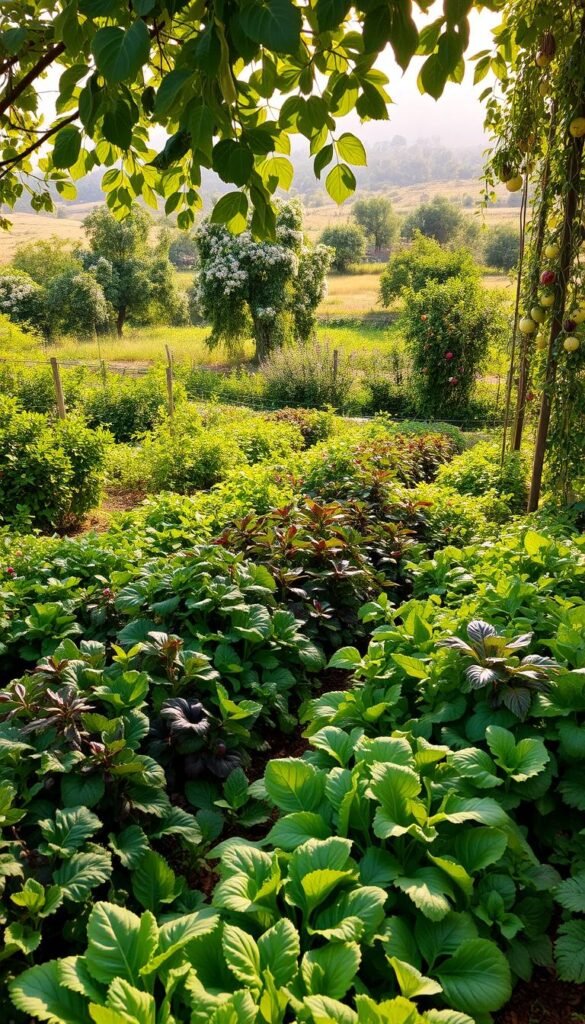
Timing is everything when your goal is a never-empty plot. Start by sketching your space into seasonal zones – dedicate areas for spring greens, summer tomatoes, and winter roots. This visual map helps spot potential gaps before they leave your kitchen empty.
Mid-July is prime time to plant broccoli and cabbage seedlings. These cold-hardy crops mature as temperatures drop, bridging autumn and early spring harvests. Pair them with leeks that sweeten under frost – nature’s way of stocking your winter larder.
Don’t forget perennial power players. Asparagus beds yield early spring spears when annuals are just sprouting. Rhubarb’s tart stalks emerge as winter retreats, offering the first fresh flavors of the year. These reliable plants act like insurance policies against crop failures.
Track what your household actually eats. If no one likes kale, replace it with Swiss chard or spinach. Use a simple notebook to record planting dates and yields – next year’s plan will practically write itself.
Leave wiggle room between beds for quick crop swaps. When garlic finishes in July, that space can host fall carrots. Smart transitions keep soil working while you enjoy steady harvests through every season.
Soil Preparation and Enrichment Techniques
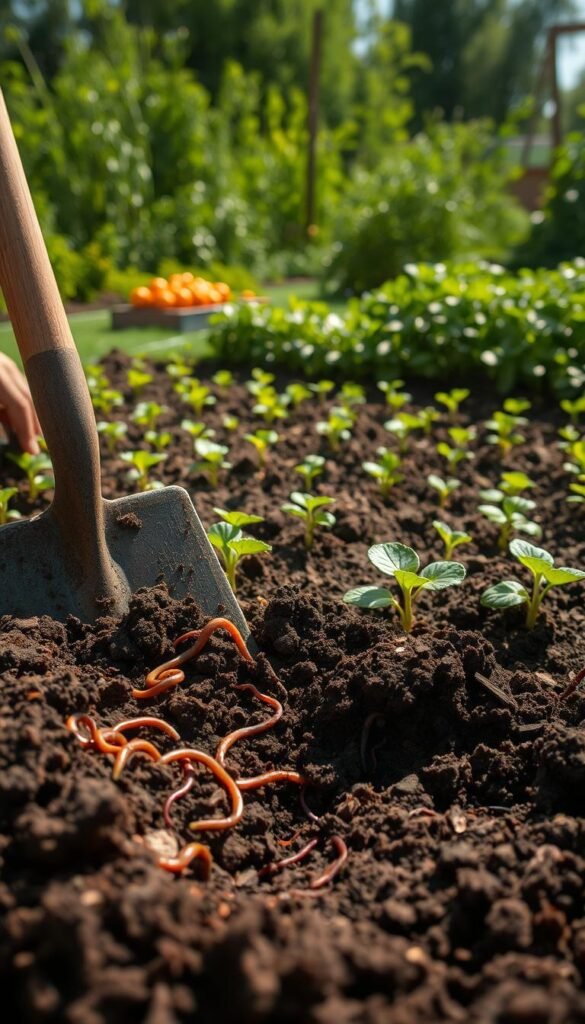
French gardeners knew something modern growers often forget: soil is the garden’s beating heart. Their secret? Layering compost and aged manure like a cozy blanket. This traditional approach kept winter crops warm while feeding microbes that break down nutrients slowly.
Your ground becomes richer when organic matter mixes into the top 6-8 inches. Think of it as making lasagna – alternating brown leaves with green kitchen scraps creates a feast for earthworms. Over time, this builds crumbly soil that lets roots breathe and drink deeply.
Protected growing spaces need special care. Soil in greenhouses misses rain showers and frost cycles that refresh outdoor beds. Every spring, mix in fresh compost or plant nitrogen-fixing clover between crops. These cover crops act like vitamin shots for tired earth.
Ever notice how a compost pile steams? That gentle heat works underground too. Burying manure or straw in fall beds creates natural warmth pockets – perfect for extending carrot harvests into December. Just remember: test your soil’s pH yearly. Most veggies thrive in slightly acidic ground (6.0-6.8).
Aim for balance – too much fertilizer burns plants, while too little leaves them hungry. Start with a simple soil test kit, then adjust using lime for acidity or sulfur for alkalinity. Your reward? Robust growth that laughs at frost dates.
Season Extension Techniques to Boost Your Harvest
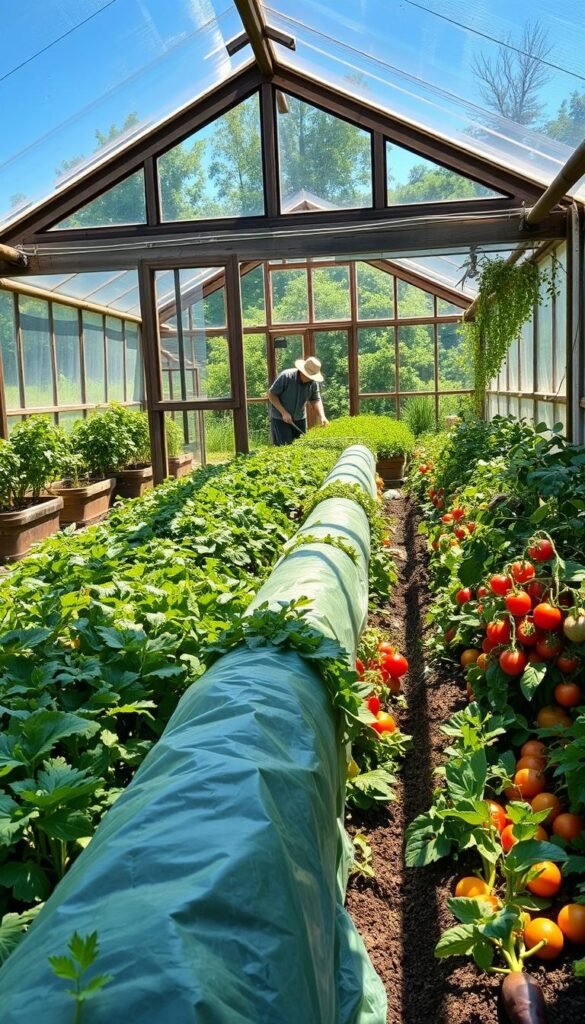
Unlock extra weeks of fresh produce by mastering simple protective structures. These tools act like cozy blankets for your plants, trapping warmth while letting sunlight work its magic. With proper planning, you’ll harvest spinach long after summer fades and carrots before spring officially arrives.
Row Covers & Cold Frames: Spring and Fall Champions
Lightweight row covers shield crops from early frosts while letting rain through. Drape them directly over plants or support with hoops for better airflow. For sturdier protection, cold frames with angled glass lids capture maximum winter sun. A well-built frame can turn Zone 6 into Zone 7 growing conditions overnight.
| Structure | Zone Shift | Materials | Best For |
|---|---|---|---|
| Row Cover | +0.5 zones | Frost cloth, PVC hoops | Lettuce, radishes |
| Cold Frame | +1 zone | Old windows, straw bales | Kale, spinach |
| Low Tunnel | +1.5 zones | Conduit, greenhouse film | Carrots, chard |
Hoop Houses: Winter’s Secret Weapon
Bend aluminum conduit into arches every 4 feet for instant low tunnels. Add row cover fabric first, then clear plastic when temperatures plummet. This double layer boosts protection by six degrees – often enough to keep greens growing through January snows. Remember to vent structures on sunny days to prevent overheating.
Pair these methods with smart seasonal planting strategies for nonstop harvests. Rotate crops based on each structure’s microclimate, and watch your garden defy calendar limitations.
How to Turn a Vegetable and Fruit Garden into a Year-Round Harvest Zone
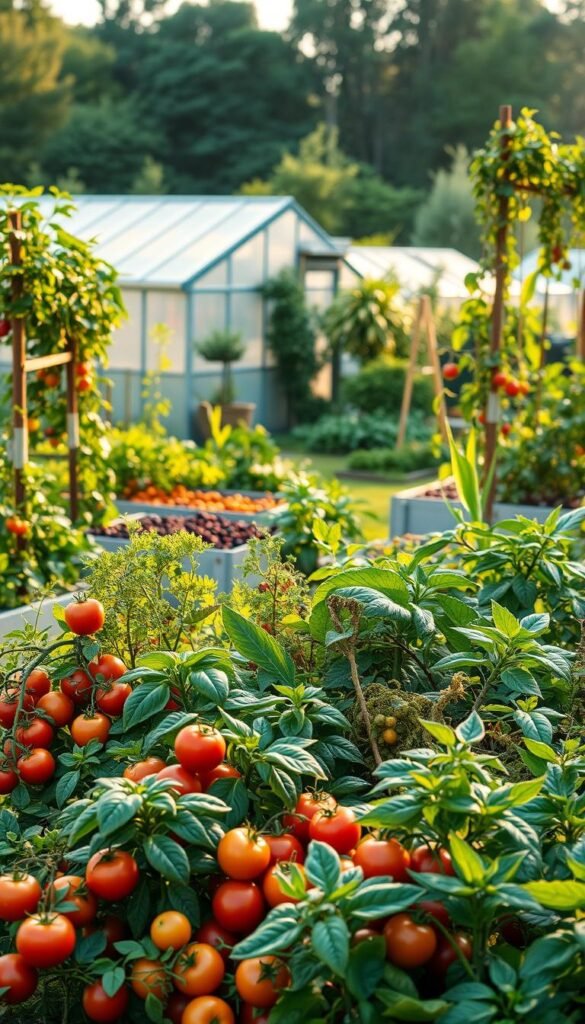
High-altitude gardener Rick Stone proves that even harsh climates can yield continuous crops. At 4,000 feet in Utah, he uses cold-hardy methods to pull carrots from snow-covered beds. His secret? Treating frost dates as harvest deadlines rather than growing limits.
Start by dividing your space into three working areas. Designate sections for active growth, winter protection, and quick crop swaps. This zoning strategy lets you rotate plants like a conveyor belt – when garlic finishes, fall greens take its spot.
Timing beats brute force in cold climates. Sow broccoli 10-12 weeks before first frost so it matures as temperatures drop. Hardy varieties like ‘Winterbor’ kale actually improve flavor after light freezes. Check this zone-specific guide:
| Zone Range | Protection Needed | Reliable Crops |
|---|---|---|
| 3-4 | Insulated cold frames | Leeks, spinach, parsley |
| 5-7 | Heavy row covers | Carrots, cabbage, turnips |
| 8+ | Shade cloth | Chard, radishes, cilantro |
Microclimates become your allies. South-facing walls radiate heat at night, creating pockets where arugula thrives while other beds freeze. Monitor these areas with simple thermometers – even 2-3°F differences matter.
Your ground doubles as nature’s refrigerator. Leave mature root crops buried under mulch until needed. They’ll stay fresher than store-bought produce while freeing up indoor storage space.
Selecting the Right Crops for Every Season
The key to year-round abundance lies in matching plants to nature’s temperature shifts. Cool-weather stars thrive when others wilt, while summer favorites demand heat to shine. Your planting choices determine whether your garden sleeps or produces through frost and heatwaves.
Cold-Hardy Champions
Winter’s bite brings out the best in certain varieties. Kale develops richer flavor after light frosts, while carrots convert starches to sugars underground. Try these resilient options:
- Leafy greens: ‘Winterbor’ kale survives -10°F, while spinach handles snow cover
- Root vegetables: ‘Napoli’ carrots stay crisp in frozen ground
- Brassicas: ‘January King’ cabbage forms tight heads in cold
Summer Power Producers
Heat-loving crops need strategic timing. Plant ‘Sungold’ tomatoes early for July harvests, then follow with fast-growing beans. Consider these high-yield choices:
| Type | Variety | Days to Harvest |
|---|---|---|
| Tomato | Celebrity Hybrid | 70 |
| Pepper | California Wonder | 75 |
| Cucumber | Marketmore 76 | 58 |
Pair cold-tolerant herbs like parsley with winter crops for fresh flavor bursts. Remember: frost dates mark harvest deadlines, not growing stops. With smart variety selection, your garden becomes a perpetual produce aisle.
Succession Planting for a Steady Yield
What if your garden produced like a well-stocked grocery aisle? Succession planting turns sporadic harvests into reliable weekly pickings. Instead of overwhelming zucchini gluts in July, you’ll enjoy manageable yields from spring through frost. Start by sowing fast-growing varieties every 2-3 weeks – think baby greens, radishes, and bush beans.
Create a nursery zone for seamless transitions. Dedicate a sunny windowsill or cold frame to start seedlings. When spinach bolts in June, you’ll have young kale plants ready to fill the gap. This rotation system keeps soil active and your kitchen stocked.
Timing is crucial for late-season crops. Plant these winners 8-10 weeks before first frost:
- Carrots: ‘Napoli’ thrives in cooling soil
- Celeriac: Needs 100+ days but stores well
- Bush beans: ‘Provider’ matures in 50 days
Match varieties to your growing window. Early tomatoes like ‘Stupice’ yield by midsummer, freeing space for fall beets. Pro tip: Use a planting chart to track sow dates and maturity times. Cooler autumn days slow growth, so add 14 extra days to seed packet estimates for late plantings.
Your secret weapon? Interplanting. Tuck quick-growing arugula between slower broccoli plants. Harvest the greens before brassicas need the space. This clever overlap maximizes every square foot while keeping your meals diverse.
Indoor Gardening and Greenhouse Setups
Your home’s unused spaces hold surprising potential for fresh flavors. A sunny windowsill becomes a herb haven, while basement corners transform into microgreen factories. With smart design, even apartments can produce salad greens during blizzards.
Optimizing Your Indoor Space
Start with compact systems like vertical planters or stackable hydroponic units. LED grow lights mimic sunlight for basil and lettuce, while adjustable racks let you grow upward. Keep humidity around 40-60% using pebble trays – crispy leaf tips often signal dry air.
Greenhouses extend possibilities beyond windowsills. Pair greenhouse gardening strategies with thermal mass like water barrels to stabilize temperatures. Auto-venting kits prevent overheating, and shade cloths protect summer crops from scorching.
Track conditions with wireless hygrometers. Most veggies thrive between 65°F–75°F, but cool-loving spinach prefers 50°F–70°F. Your secret weapon? Oscillating fans – they strengthen plant stems while preventing mold in humid environments.






